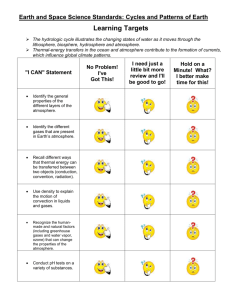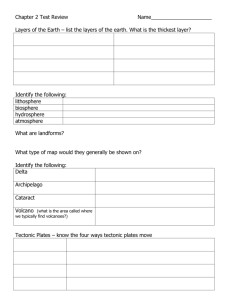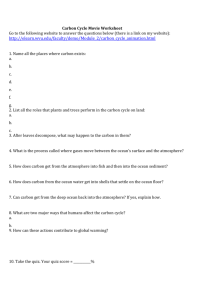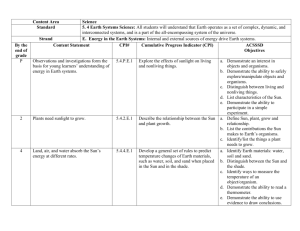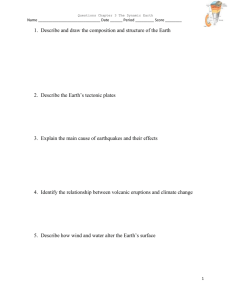Chapter 3 Notes
advertisement
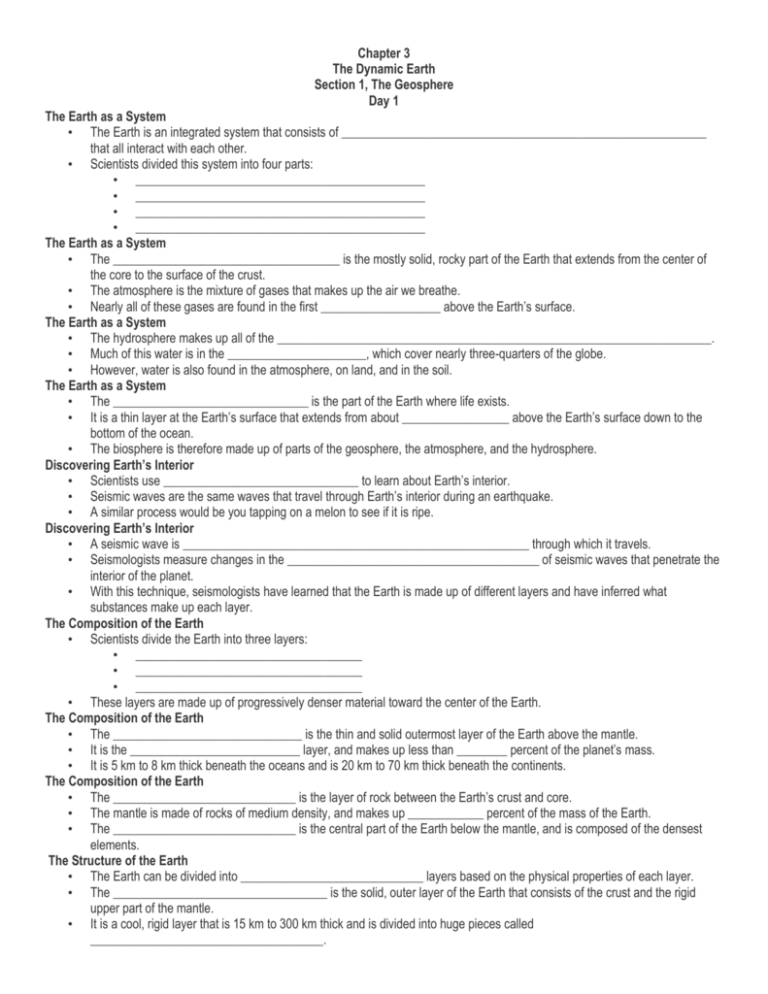
Chapter 3 The Dynamic Earth Section 1, The Geosphere Day 1 The Earth as a System • The Earth is an integrated system that consists of __________________________________________________________ that all interact with each other. • Scientists divided this system into four parts: • ______________________________________________ • ______________________________________________ • ______________________________________________ • ______________________________________________ The Earth as a System • The ____________________________________ is the mostly solid, rocky part of the Earth that extends from the center of the core to the surface of the crust. • The atmosphere is the mixture of gases that makes up the air we breathe. • Nearly all of these gases are found in the first ___________________ above the Earth’s surface. The Earth as a System • The hydrosphere makes up all of the _____________________________________________________________________. • Much of this water is in the ______________________, which cover nearly three-quarters of the globe. • However, water is also found in the atmosphere, on land, and in the soil. The Earth as a System • The _______________________________ is the part of the Earth where life exists. • It is a thin layer at the Earth’s surface that extends from about _________________ above the Earth’s surface down to the bottom of the ocean. • The biosphere is therefore made up of parts of the geosphere, the atmosphere, and the hydrosphere. Discovering Earth’s Interior • Scientists use _______________________________ to learn about Earth’s interior. • Seismic waves are the same waves that travel through Earth’s interior during an earthquake. • A similar process would be you tapping on a melon to see if it is ripe. Discovering Earth’s Interior • A seismic wave is _______________________________________________________ through which it travels. • Seismologists measure changes in the ________________________________________ of seismic waves that penetrate the interior of the planet. • With this technique, seismologists have learned that the Earth is made up of different layers and have inferred what substances make up each layer. The Composition of the Earth • Scientists divide the Earth into three layers: • ____________________________________ • ____________________________________ • ____________________________________ • These layers are made up of progressively denser material toward the center of the Earth. The Composition of the Earth • The ______________________________ is the thin and solid outermost layer of the Earth above the mantle. • It is the ___________________________ layer, and makes up less than ________ percent of the planet’s mass. • It is 5 km to 8 km thick beneath the oceans and is 20 km to 70 km thick beneath the continents. The Composition of the Earth • The _____________________________ is the layer of rock between the Earth’s crust and core. • The mantle is made of rocks of medium density, and makes up ____________ percent of the mass of the Earth. • The _____________________________ is the central part of the Earth below the mantle, and is composed of the densest elements. The Structure of the Earth • The Earth can be divided into _____________________________ layers based on the physical properties of each layer. • The __________________________________ is the solid, outer layer of the Earth that consists of the crust and the rigid upper part of the mantle. • It is a cool, rigid layer that is 15 km to 300 km thick and is divided into huge pieces called _____________________________________. The Structure of the Earth • The _________________________________ is the solid, plastic layer of the mantle beneath the lithosphere. • It is made of _____________________________________ that flows slowly, which allows tectonic plates to move on top of it. • Beneath the asthenosphere is the __________________________________, the lower part of the mantle. The Structure of the Earth • The Earth’s __________________________________ is a dense liquid layer. • At the center of the Earth is a dense, solid inner core, which is made up mostly of ______________________________________________________. • Although the temperature of the inner core is estimated to be between 4,000°C to 5,000°C, it is solid because it is under enormous pressure. • The inner and outer core make up about _____________________________ of Earth’s mass. Plate Tectonics • ____________________________________________ are blocks of lithosphere that consist of the crust and the rigid, outermost part of the mantle and glide across the underlying asthenosphere. • The continents are located on tectonic plates and move around with them. • The major tectonic plates include the Pacific, North America, South America, Africa, Eurasian, and Antarctic plates. Plate Boundaries • Much of the geological activity at the surface of the Earth takes place at the boundaries between tectonic plates. • Tectonic plates may __________________________________________ past one another. • Enormous forces are generated with these actions causing mountains to form, earthquakes to shake the crust, and volcanoes to erupt along the plate boundaries. Plate Tectonics and Mountain Building • Tectonic plates are continually moving around the Earth’s surface. • When tectonic plates collide, slip by one another, or pull apart, enormous forces cause rock to ___________________________________________. • Where plates collide, the crust becomes thicker and eventually forms mountain ranges, such as the Himalaya Mountains. Earthquakes • A ___________________________________ is a break in the Earth’s crust along which blocks of the crust slide relative to one another. • When rocks that are under stress suddenly break along a fault, a series of ground vibrations, known as ________________________________, is set off. • Earthquakes are occurring all the time. Many are so small that we cannot feel them, but some are enormous movements of the Earth’s crust that cause widespread damage. Earthquakes • The measure of the energy released by an earthquake is called ___________________________________. • The smallest magnitude that can be felt is 2.0, and the largest magnitude ever recorded is 9.5. Magnitudes greater than 7.0 cause widespread damage. • Each increase of magnitude by one whole number indicates the release of __________________ times more energy than the whole number below it. Where do Earthquakes Occur? • The majority of earthquakes take place at or near tectonic plate boundaries because of the enormous stresses that are generated when tectonic plates separate, collide, or slip past each other. • Over the past 15 million to 20 million years, large numbers of earthquakes have occurred along the San Andreas Fault in California, where parts of the North America plate and the Pacific plate are slipping past one another. Earthquake Hazard • Scientists cannot predict when earthquakes will take place. However, they can help provide information about where earthquakes are likely to occur helping people prepare. • An area’s ________________________________________________ is determined by past and present seismic activity. • Earthquake-resistant buildings, built in high-risk areas, are slightly flexible so that they can sway with the ground motion preventing them from collapsing. Volcanoes • A _______________________________ is a mountain built from magma, or melted rock, which rises from the Earth’s interior to the surface, and can occur on land or in the sea. • Volcanoes are often located near tectonic plate boundaries where plates are either colliding or separating from one another. • The majority of the world’s active volcanoes on land are located along tectonic plate boundaries that surround the ______________________________________. Local Effect of Volcanic Eruptions • Clouds of host ash, dust, and gases can flow down the slope of a volcano at speeds of up to ________________________________ and sear everything in their path. • During an eruption, volcanic ash can mix with water and produce mudflow that runs downhill. • In addition, ash that falls to the ground can cause buildings to collapse under its weight, bury crops, damage the engines of vehicles, and cause breathing difficulties. Global Effects of Volcanic Eruptions • Major volcanic eruptions can change Earth’s climate for several years. • In large eruptions, clouds of volcanic ash and sulfur rich gases may reach the upper atmosphere, and spread across the planet ____________________________________________________________ that reaches the Earth’s surface. • The reduction in sunlight can cause a drop in the ____________________________________________________________. Erosion • The Earth’s surface is continually battered by wind and scoured by running water, which moves rocks around and changes their appearance. • ____________________________ is the process in which the materials of the Earth’s surface are loosened, dissolved, or worn away and transported from one place to another by a natural agent, such as wind, water, ice, or gravity. • Erosion wears down rocks and makes them smoother as times passes. Older mountains are therefore smoother than younger ones. Water Erosion • Erosion by both rivers and oceans can produce dramatic changes on Earth’s surface. • Waves from ocean storms can erode coastlines to give rise to a variety of landforms, • Over time, rivers can carve deep gorges into the landscape. Wind Erosion • _______________________ also changes the landscape of the planet. • In places where few plants grow, such as beaches and deserts, wind can blow soil away very quickly. • Soft rocks, such as sandstone, erode more easily than hard rocks, such as granite do. Graphic Organizer: The Dynamic Earth Chapter 3 The Dynamic Earth Section 2, The Atmosphere Day 1 The Atmosphere • The ____________________________________ is a mixture of gases that surrounds a planet, such as Earth. • ______________________________________________________________________ are all parts of this mixture. • Gases can be added to and removed from the atmosphere through living organisms. • For example, animals remove oxygen when they breathe in and add carbon dioxide when they breathe out. The Atmosphere • ___________________________________________ also add gases to the atmosphere, while vehicles both add and remove gases. • The atmosphere also ___________________________ Earth’s surface. • This insulation _________________________ the rate at which the Earth’s surface loses heat and keeps Earth temperature at which living things can survive. Composition of the Atmosphere • Nitrogen makes up __________percent of the Earth’s atmosphere, and enters the atmosphere when volcanoes _________________________________________________________________. • Oxygen is the _____________________ most abundant gas in the atmosphere and is primarily produced by plants. • In addition to gases, the atmosphere contains many types of tiny, solid particles, or ______________________________________. Composition of the Atmosphere • In addition to nitrogen and oxygen, other gases such as ___________________________________________________________________ make up the rest of the atmosphere. Air Pressure • Earth’s atmosphere is pulled toward Earth’s surface by ____________________________ and as a result, the atmosphere is ____________________________ near the Earth’s surface. • Almost the entire mass of Earth’s atmospheric gases is located within _________________________ of the surface. • Air also becomes less dense with ____________________________, so breathing at higher elevations is more difficult. Layers of the Atmosphere • The atmosphere is divided into four layers based on temperature changes that occur at different distances above the Earth’s surface. • ________________________________________________ • ________________________________________________ • ________________________________________________ • ________________________________________________ The Troposphere • The __________________________________ is the lowest layer of the atmosphere in which temperature drops at a constant rate as altitude increases. • This is the part of the atmosphere where ___________________________________ exist. • The troposphere is Earth’s __________________________ atmospheric layer and extends to 18 km above Earth’s surface. The Stratosphere • The _______________________________ is the layer of the atmosphere that lies immediately above the troposphere and extends from about 10 to 50 km above the Earth’s surface. • Temperature ________________________________________________ because ozone in the stratosphere absorbs the sun’s ultraviolet (UV) energy and warms the air. The Stratosphere • ___________________________________ is a gas molecule that is made up of three oxygen atoms. • Almost all of the ozone in the atmosphere is concentrated in the ____________________________________. • Because ozone absorbs _____________________________, it reduces the amount of UV radiation that reaches the Earth. • UV radiation that does reach Earth can _______________________________________. The Mesosphere • The layer above the stratosphere is the _______________________________________. This layer extends to an altitude of about 80 km. This is the _______________________________________ of the atmosphere where temperatures have been measured as low as –93ºC. The Thermosphere • The atmospheric layer located farthest from Earth’s surface is the __________________________________________. • Here, nitrogen and oxygen absorb ________________________________ resulting in temperatures measuring above 2,000 ºC. • The air in the thermosphere is so thin that air particles rarely collide, so little heat is transferred, and would therefore not feel hot to us. The Thermosphere • The absorption of ______________________________________ by nitrogen and oxygen causes atoms to become electrically charged. • Electrically charged atoms are called _______________________, and the lower thermosphere is called the _________________________________. • Ions can radiate energy as light, and these lights often glow in spectacular colors in the night skies near the Earth’s North and South Poles. Energy Transfer in the Atmosphere • ________________________________ is the energy that is transferred as electromagnetic waves, such as visible light and infrared waves. • ________________________________ is the transfer of energy as heat through a material. • ________________________________ is the movement of matter due to differences in density that are caused by temperature variations an can result in the transfer of energy as heat. Heating of the Atmosphere • Solar energy reaches the Earth as ____________________________________________, which includes visible light, infrared radiation, and ultraviolet light. • About ___________________________ of the solar energy that enters the atmosphere passes through it and reaches the Earth’s surface, while the rest of the energy is absorbed or reflected in the atmosphere by clouds, gases, and dust or it is reflected by Earth’s surface. Heating of the Atmosphere • The Earth does not continue to get warmer because the oceans and the land radiate the absorbed energy back into the atmosphere. • Dark-colored objects absorb more solar radiation that light-colored objects, so dark colored objects have more energy to release as heat. • This is one reason the temperature in cities is higher that the temperature in the surrounding countryside. The Movement of Energy in the Atmosphere • As a current of air, warmed by the Earth’s surface, rises into the atmosphere, it begins to cool, and eventually become denser than the air around it and sinks. • This current then moves back toward the Earth until heated and less dense and then begins to rise again. • The continual process of warm air rising and cool air sinking and moving air in a circular motion is called a ____________________________________. The Greenhouse Effect • The ______________________________________ is the warming of the surface and lower atmosphere of Earth that occurs when carbon dioxide, water vapor, and other gases in the air absorb and reradiate infrared radiation. • Without the greenhouse effect, the Earth would be too cold for life to exist. The Greenhouse Effect • The gases in the atmosphere that trap and radiate heat are called ______________________________________. • The most abundant greenhouse gases are __________________________________________________________________, although none exists in high concentrations. • The quantities of carbon dioxide and methane in the atmosphere vary considerably because of natural and industrial processes. • • Chapter 3 The Dynamic Earth Section 3, The Hydrosphere and Biosphere Day 1 The Hydrosphere • The ________________________________ includes all of the water on or near the Earth’s surface. • This includes water in the oceans, lakes, rivers, wetlands, polar ice caps, soil, rock layers beneath Earth’s surface, and clouds. The Water Cycle • The ________________________________ is the continuous movement of water from the ocean to the atmosphere to the land and back to the ocean. • ____________________________________ is the change of a substance from a liquid to a gas. • Water continually evaporates from the Earth’s oceans, lakes, streams, and soil, but the majority evaporates from the oceans. The Water Cycle • ___________________________________ is the change of state from a gas to a liquid. • Water vapor forms water droplets on dust particles, which then form clouds in which the droplets collide to create larger, heavier drops that then fall from the clouds as rain. • ___________________________________ is any form of water that falls to the Earth’s surface from the clouds, and includes rain, snow, sleet, and hail. Earth’s Oceans • All of the oceans are joined in a single large interconnected body of water called the ___________________________________________________. The world oceans play important roles in the regulation of the ___________________________________________________. Earth’s Oceans • The largest ocean on Earth is the __________________________________________ with a surface area of about 165,640,000 km2. • The deepest point on the ocean floor, the ____________________________________, is found in the Pacific Ocean. • The Challenger Deep is located east of the Philippine islands at the bottom of the Mariana Trench and is 11,033m below sea level which is deeper than Mount Everest is tall. Earth’s Oceans • Oceanographers often divide the Pacific Ocean into the North Pacific and South Pacific based on the ______________________________________________________flow in each half of the Pacific Ocean. • Surface currents in the Pacific move in a _________________________________ direction north of the equator. • Surface currents in the Pacific move in a _________________________________ direction south of the equator. Earth’s Oceans • The second largest ocean on Earth is the _______________________________________, and covers about half the area of the Pacific Ocean, which is a surface area of about 81,630,000 km2. • Like the Pacific Ocean, the Atlantic Ocean can be divided into a north and south half based on the directions of surface current flow north and south of the equator. Earth’s Oceans • The ___________________________________________ is the third largest ocean on Earth with a surface area of 73,420,000 km2. • The smallest ocean is the __________________________________, which covers 14,350,000 km2. • The Arctic Ocean is unique because much of its surface is covered by floating ice, called _________________________________, which forms when either waves or wind drive together frozen seawater, known as sea ice, into a large mass. Ocean Water • The difference between ocean water and fresh water is that ocean water contains more salts. • __________________________________ is a measure of the amount of dissolved salts in a given amount of liquid. • Salinity is lower in places that get _______________________________________________________________________. • In contrast, salinity is higher where water evaporates rapidly and leaves the salts behind. Ocean Water • Most of the salt in the ocean is ____________________________________________, which is made up of the elements sodium and chloride, although many other elements can be found in the ocean as well. Temperature Zones • The surface of the ocean is ________________________________________________, while the depths of the ocean, where sunlight never reaches, are very cold, just above freezing. Surface waters are stirred up by ___________________________________________ so the warm surface zone may be as much as 350 m deep. • Below the surface zone is the ____________________________________, which is a layer about 300 to 700 m deep where the temperature falls rapidly. A Global Temperature Regulator • One of the most important functions of the world ocean is to __________________________________________________________ from sunlight which in turn regulates temperatures in Earth’s atmosphere. • Because the ocean both absorbs and releases heat slower than land, the temperature of the atmosphere changes more slowly. • If the ocean did not regulate atmospheric and surface temperatures, temperatures would be too extreme for life to exist on Earth. A Global Temperature Regulator • Local temperatures in different areas of the planet are also regulated by the world ocean. • Currents circulate warm water causing land areas they flow past to have climates that are more moderate. • For example, the British Isles are warmed by the waters of the Gulf Stream. Ocean Currents • Stream like movements of water that occur at or near the surface of the ocean are called ______________________________________________________. • Surface currents are ________________________________ and result from global wind patterns. • Surface currents can be __________________________________________ currents. However, currents of warm water and currents of cold water do not readily mix with one another. Ocean Currents • ________________________________________ are stream like movements of water that flow very slowly along the ocean floor. • Deep currents form when the cold, dense water from the poles _______________________ below warmer, less dense ocean water and flows toward the equator. • The densest and coldest ocean water is located off the coast of Antarctica and flows very slowly northward producing a deep current called the Antarctic Bottom Water. Fresh Water and River Systems • ___________________________________ is water that contains insignificant amounts of salts. • Most of the fresh water is locked up in icecaps and glaciers while the rest is found in places like lakes, rivers, wetlands, the soil and atmosphere. • A ___________________________________ is a network of streams that drains an area of land and contains all of the land drained by a river including the main river and all its smaller streams or rivers that flow into larger ones, or tributaries. Ground water • Rain and melting snow sink into the ground and run off the land. Most of this water trickles down through the ground and collects as __________________________________. • Although it makes up only _____________ percent of all the water on Earth, groundwater fulfills the human need for fresh drinking water, and supplies agricultural and industrial need. Aquifers • A rock layer that stores and allows the flow of groundwater is called an _______________________________________. The Biosphere • The ___________________________________ is the part of Earth where life exists, extending about 11 km into the ocean and about 9 km into the atmosphere. • The materials that organisms require must be continually recycled. • _______________________________________ allows a planet to maintain an atmosphere and to cycle materials. • Suitable combinations that organisms need to survive are found only in the biosphere. The Biosphere • The ____________________________________ is located near Earth’s surface because most of the sunlight is available near the surface. • Plants need sunlight to produce their food, and almost every other organism gets its food from plants and algae. • Most of the algae float at the surface of the ocean and is known as phytoplankton. Energy Flow in the Biosphere • The energy used by organisms must be obtained in the biosphere and must be constantly supplied for life to continue. • When an organism dies, its body is broken down and the nutrients in it become available for use by other organisms. • This flow of energy allows life on Earth to continue to exist. • Energy Flow in the Biosphere • _________________________________________ are systems that cannot exchange matter or energy with its surroundings. • _________________________________________ are systems that can exchange both matter and energy with its surroundings. • Today, the Earth is essentially a closed system with respect to matter, but an open system for energy as energy travels from plant to animal, which is eaten by other animals. • In the process, some energy is lost as ___________________ to the environment.
